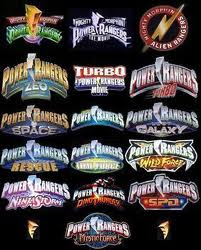1. Mighty Morphin Power Rangers
2. Mighty Morphin Power Rangers: The
Fighting Edition
3. Power Rangers: Super Legends
Berikut keterangan lebih lanjut tentang urutan Power Rangers...
* Mighty Morphin Power Rangers, the longest-running series, aired from 1993 to 1995, spanning three seasons. In those three seasons, MMPR used footage, costumes, and props from three of the Super Sentai Series: Kyōryū Sentai Zyuranger for season 1, Gosei Sentai Dairanger for season 2, and Ninja Sentai Kakuranger for season 3. In 2010, MMPR was re-versioned for broadcast.
o Mighty Morphin Alien Rangers aired in early 1996 as a miniseries that served as a link between MMPR and Zeo. It also utilized footage and props from Kakuranger and featured the costumes used by the Kakurangers as the footage for the Alien Rangers.
* Power Rangers: Zeo aired in 1996 and featured the first change in costume for the American Power Rangers, using footage from Chouriki Sentai Ohranger.
* Power Rangers: Turbo aired in 1997 and also had a movie with the series, titled Turbo: A Power Rangers Movie which acted as the bridge between Zeo and Turbo, and introduced Justin Stewart, the youngest Power Ranger. Turbo used footage from Gekisou Sentai Carranger.
* Power Rangers in Space aired in 1998. It ended a story-arc concerning the character Zordon and introduced the Battlizer armor, unique to the American productions. The in Space series took footage from Denji Sentai Megaranger.
* Power Rangers: Lost Galaxy aired in 1999. Whereas all of the previous series featured interconnections in their casts and characters. Lost Galaxy used an entirely new cast of characters play the Power Rangers. Lost Galaxy also began the trend of the "team up" crossover episode where the current team meets with the previous team to fight a common enemy. Lost Galaxy used props and footage from Seijuu Sentai Gingaman.
* Power Rangers: Lightspeed Rescue aired in 2000 and featured the first entirely American-produced Power Ranger, the Titanium Ranger. Lightspeed Rescue used footage, costumes, and props from Kyuukyuu Sentai GoGoFive.
* Power Rangers: Time Force aired in 2001. The last series fully produced by Saban Entertainment, Time Force used footage and props from Mirai Sentai Timeranger.
* Power Rangers: Wild Force (the first series produced partly by BVS Entertainment) aired in 2002. As the 10th anniversary series, it also featured an anniversary crossover episode titled "Forever Red" where every series' original Red Ranger up until that point returned to fight a common enemy. Wild Force used footage and props from Hyakujuu Sentai Gaoranger. Wild Force was the final season to be filmed in the United States.
* Power Rangers: Ninja Storm aired in 2003. The first series produced entirely by BVS Entertainment and filmed in New Zealand, it did not feature a crossover episode and had a completely separate storyline from the previous ten seasons. Ninja Storm used footage and costumes from Ninpuu Sentai Hurricaneger.
* Power Rangers: Dino Thunder aired in 2004 and re-introduced Jason David Frank's character Tommy Oliver, who had previously appeared in Mighty Morphin, Zeo, and Turbo. Set in the same universe as the first ten seasons, it also retconned Ninja Storm. Dino Thunder used footage from Bakuryū Sentai Abaranger.
* Power Rangers: S.P.D. aired in 2005: the first series to take place in a future timeline. Like its Japanese counterpart Tokusou Sentai Dekaranger it featured more than six Rangers, two of which only appeared once.
* Power Rangers: Mystic Force aired in 2006 and is the first series to have a cast of entirely Australians and New Zealanders, as well as the first BVS-produced series to use only the antagonists of its Super Sentai counterpart, Mahou Sentai Magiranger.
* Power Rangers: Operation Overdrive aired in 2007 and was the 15th anniversary season for the franchise, featuring the crossover episode Once a Ranger that featured the return of Johnny Yong Bosch's character Adam Park. Operation Overdrive used footage and costumes from GoGo Sentai Boukenger.
* Power Rangers: Jungle Fury aired in 2008 and is the first BVS-produced series to introduce original Power Rangers, the Spirit Rangers. Like its Super Sentai counterpart Juken Sentai Gekiranger, Jungle Fury also featured the first Zords used by the villains that could combine with the Power Rangers' Megazord in cooperation.
* Power Rangers: RPM, the seventeenth series, premiered in March 2009. It is the second series to take place in a futuristic setting and the first to take place in a post-apocalyptic setting. This series uses costumes and footage from Engine Sentai Go-onger.
materi referensi:
http://en.wikipedia.org/wiki/Power_Rangers



mantap
ReplyDelete